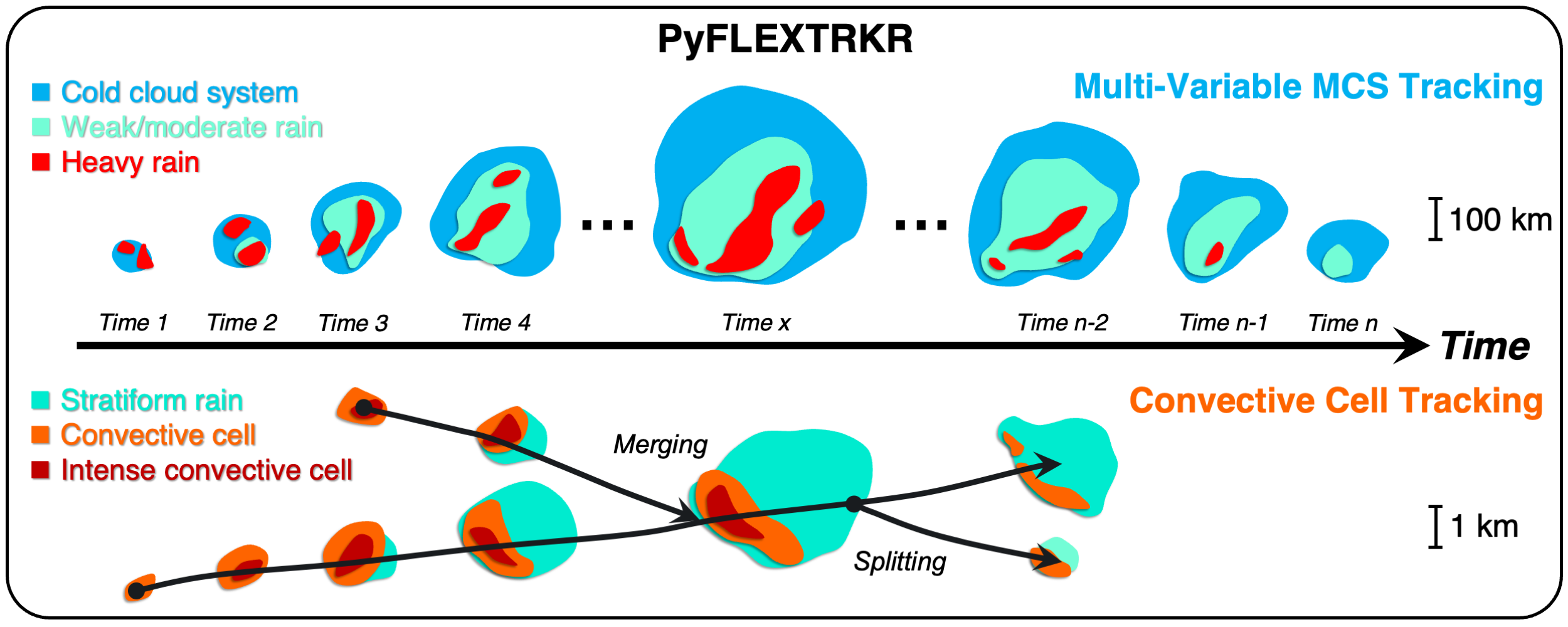The Python FLEXible object TRacKeR (PyFLEXTRKR) is a flexible atmospheric feature tracking software package. The software can track any 2D objects and handle merging and splitting explicitly. PyFLEXTRKR has specific capabilities to track convective clouds from a variety of observations and model simulations, including: 1) individual convective cells, and 2) mesoscale convective systems (MCSs) using radar, satellite, and model data. The package has scalable parallelization options and has been optimized to work on large datasets including global kilometer-scale data.
For a more detailed user guide, click this link.
PyFLEXTRKR works with netCDF files using Xarray's capability to handle N-dimension arrays of gridded data. Currently, PyFLEXTRKR supports tracking:
- Individual convective cells using radar reflectivity data [Feng et al. (2022), MWR];
- MCSs using infrared brightness temperature (Tb) data from geostationary satellites, or outgoing longwave radiation (OLR) data from model simulations, with optional collocated precipitation data [Feng et al. (2021), JGR] or 3D radar reflectivity data [Feng et al. (2018) JAMES; Feng et al. (2019), JCLI] to identify robust MCSs;
- Generic 2D objects defined by customizable feature identification functions.
The input data must contain at least 3 dimensions: time, y, x, with corresponding coordinates of time, latitude, longitude. The latitude and longitude coordinates can be either 1D or 2D. But the data must be on a fixed 2D grid (any projection is fine) since PyFLEXTRKR only supports tracking data on 2D arrays. Irregular grids such as those in E3SM or MPAS model must first be regridded to a regular grid before tracking. Additional variable names and coordinate names are specified in the config file. See user guide for more details in preparing the input dataset.
Clone PyFLEXTRKR to your local computer (e.g., /PyFLEXTRKR):
git clone https://github.com/FlexTRKR/PyFLEXTRKR.gitGo to that directory:
cd /PyFLEXTRKRUse the included environment.yml file to create a Conda virtual environment, make sure you change conda_env_dir to where your conda environments are installed:
conda env create -f environment.yml --prefix /conda_env_dir/flextrkrPro Tips: using mamba to create the virtual environment is much faster:
mamba env create -f environment.yml --prefix /conda_env_dir/flextrkrAfter setting up the Conda virtual environment, activate it with:
conda activate flextrkrThen install the package with:
pip install -e .Any changes to the source code will be reflected in the running version.
Several scripts are provided to download example input data, run tracking, and produce visualizations of the tracking results below:
-
Convective cell tracking from 500 m gridded NEXRAD radar data
-
Convective cell tracking from 500 m gridded ARM CSAPR radar data
To run these demo scripts, download the script, modify the dir_demo in the script to a directory on your computer to store the sample data, and run the following command:
bash demo_cell_nexrad.shThe demo script downloads and untar the sample data, runs the tracking code, and generates visualizations. Once the demo script finishes running, a sub-directory within the dir_demo named quicklooks_trackpaths will be created that contains quicklook visualization of the tracking results, as shown in the example animations above.
To run the code, type the following in the command line:
Activate PyFLEXTRKR virtual environment:
conda activate flextrkrRun PyFLEXTRKR:
python ../runscripts/run_celltracking.py ./config/config_nexrad500m_example.ymlpython ./runscripts/run_mcs_tbpf.py ./config/config_wrf4km_mcs_tbpf_example.ymlA Gallery of Statistical Analysis that can be applied to the tracking outputs is provided. Below are some examples.
Feng, Z., Hardin, J., Barnes, H. C., Li, J., Leung, L. R., Varble, A., & Zhang, Z. (2023). PyFLEXTRKR: a flexible feature tracking Python software for convective cloud analysis. Geosci. Model Dev., 16(10), 2753-2776. https://doi.org/10.5194/gmd-16-2753-2023
Feng, Z., Varble, A., Hardin, J., Marquis, J., Hunzinger, A., Zhang, Z., & Thieman, M. (2022). Deep Convection Initiation, Growth, and Environments in the Complex Terrain of Central Argentina during CACTI. Monthly Weather Review, 150(5), 1135-1155. https://doi.org/10.1175/MWR-D-21-0237.1
Feng, Z., Leung, L. R., Liu, N., Wang, J., Houze, R. A., Li, J., et al. (2021). A Global High‐Resolution Mesoscale Convective System Database Using Satellite‐Derived Cloud Tops, Surface Precipitation, and Tracking. Journal of Geophysical Research: Atmospheres, 126(8). https://doi.org/10.1029/2020JD034202
Feng, Z., Leung, L. R., Houze, R. A., Hagos, S., Hardin, J., Yang, Q., et al. (2018). Structure and Evolution of Mesoscale Convective Systems: Sensitivity to Cloud Microphysics in Convection-Permitting Simulations Over the United States. Journal of Advances in Modeling Earth Systems, 10(7), 1470-1494. https://doi.org/10.1029/2018MS001305
Feng, Z., Houze, R. A., Leung, L. R., Song, F., Hardin, J. C., Wang, J., et al. (2019). Spatiotemporal Characteristics and Large-scale Environments of Mesoscale Convective Systems East of the Rocky Mountains. Journal of Climate, 32(21), 7303-7328. https://doi.org/10.1175/JCLI-D-19-0137.1






